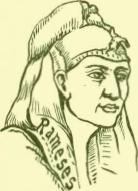MONGOLIAN CIVILIZATION. 23
eye, an impossible position. They drew the ear much too high on the side head. And they made impossible perspective for limbs without muscles. We may well admire the patience required to rear their enormous pyramids and temples, but it is foolish to think that such art required many long centuries for its development. The palm and the lotus of Egypt gave them admirable models for columns and capitals, and in the imitation of these they attained a high excellence. Their work in these still gives models of a high order for the modern architect.
With painstaking fidelity, the sculptured bas-reliefs
of Egypt represent the minute details of their daily life, not less than the public affairs of their rulers. We know how they cooked, how they ate and drank, and how they bathed and dressed themselves. We see alike their work in the shop, the house, and the field.
In all these Egyptian monu
ments we are not able to trace any long and gradual growth out of the barbarous conditions into those of a higher kind. They reached very quickly all that it was possible for them to attain. Under the influence of economy, mobility, arrogance, defense and destruction, directed by sensation, perception, memory and the lower reason, with these for ruling faculties, there could be no high development of either science or art as we understand them. An eternal sphinx stood before the deeper problems of life. All Egypt fixed its gaze downward and backward. But progress for man does not lie in that direction.
When Psametek I. opened the Egyptian ports to
foreign commerce (624 B. C.) it stimulated the Greeks to a new intellectual activity, but the reaction was disastrous to the old Egyptian civilization itself. It quickly invited foreign invasion, and first Cambyses subdued the country (525 B. C.) and later Alexander planted the city named after him, and under the splendid dynasty of the Ptolemies, Egypt became like a Grecian colony.
In its early times, the lower, middle and upper parts of Egypt usually had independent rulers, though all were essentially the same race of people. The separate and mixed records of these dynasties have thrown the early dates of Egyptian history into hopeless confusion. The most learned men of our day differ among themselves by 5,ooo years concerning dates which some of them place less than 5,ooo years back of our own time. Back of the sixteenth century,
B. C., all the dates are uncertain.
CHINESE CIVILIZATION emerged from
the mists of tradition about 2358 B. C. At that time the reigns of Yaou and his successor Shun exhibit well established institutions. The Chinese already worked in metals. They wove flax into garments and they raised sheep. The
Princess Se-ling-she had discovered how to produce and weave silk from cocoons.
The Chinese character displays the dominant instincts of familism. Around these were grouped their ruling faculties of form, color, memory, sensation, appetite and economy. Their strong filial love adapted them to a paternal form of government.

